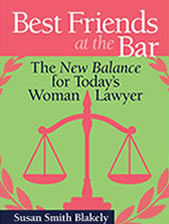Making partner in a law firm has been the traditional “pay off” for most lawyers. It is when they have confirmation that they “have arrived” as legal practitioners. Although there are trends away from that these days with a growing focus on the “life” part of the work-life balance for both men and women, partnership remains a real draw for most lawyers in private practice.
Today we are seeing a reversion to one-tier partnership by large firms like DLA and Akin Gump, and we can expect to see other firms falling in line in the future. Although that restructuring can have the positive effect of providing more practice styles and options at the mid-levels of law firms, the return to one-tier partnerships will make partnership even more of the brass ring than it has been in recent years.
For women lawyers, making partner can be a very big deal. Although approximately 50% of the graduates of law schools today are women, only 20% of the partners in law firms are women. As a result, it is a very significant accomplishment for the women who make it to that level.
But, have they really “made it?” That depends on how you define it. Yes, they have the title, but what about the amenities? What about salary, for instance?
According to an article in Think Progress, citing a study in Sky Analytics, a legal invoicing company, women lawyers can work longer and harder but still be paid less. The conclusion from the study was that “no matter what tier firm women work at, [as] determined by the number of attorneys and its geographic footprint, [the women] will be billed at significantly lower rater per hour” than men. For instance, although 2 per cent of men at top tier firms are billed at over $1000 an hour, virtually no women bill at that rate and, while half of the men in the top tier firms bill at more than $ 500 per hour, less than a third of the women have that billing rate.
Other findings were that women’s billing rates rise less over time than men’s, that female law firm partners work more hours than men, and that women in the profession earn about 87 per cent of what men make.
And that is not all. According to a recent article on the Above the Law blog, quoting Vivien Chen of The Careerist summarizing the NAWL 2013 Report, men dominate the lateral equity partner ranks, and women are well-represented in lower-status positions (like associates, of counsel, nonequity partners and staff lawyers). These results prompted the Above the Law editors to lament that Biglaw firms have not “realized that women have a rightul place in this profession, and deserve to be treated as fairly and as equally as their male counterparts.” The editors went on to describe themselves as “clearly and painfully delusional” to have thought otherwise.
The Above the Law article concluded:
“We’re left wondering why Biglaw firms keep claiming that they’re attempting to advance women within their firms. They claim to have written programs to promote the advancement of women, but it seems that they’ve yet to get with them. They’ve ‘repeatedly advised that they are committed to the goal of increasing gender equity,’ but the results of that goal are nowhere to be seen. If these firms actually gave one damn about their female attorneys — beyond touting the fact that they have real, live women working at the firm — then we’d have seen more progress by now.”
Hear, hear. Women lawyers beware. The Glass Ceiling is still firmly in place.












